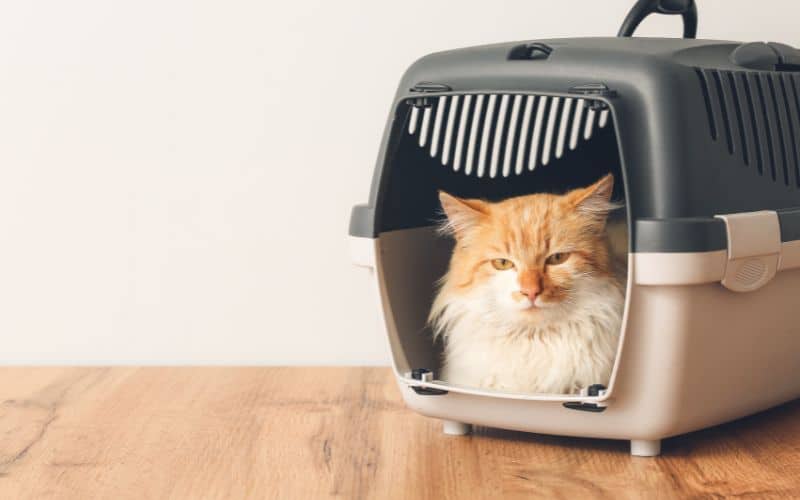Moving to a new home can be incredibly stressful, not just for us but for our furry friends as well. For cats, a home is their territory, so moving disrupts their sense of security and routine. While some cats adjust well to a new environment, others may have difficulty coping with all the changes that come with moving. Cats are entirely different than dogs when it comes to relocating to a new home. The good news is there are steps you can take to help make the change easier on your cats.
In this guide, we’ll share some vet-approved simple tips and tricks for moving cats to a new home. You’ll learn how to prepare your cats, make them feel comfortable and safe on moving days, and help them quickly get used to their new home. Following these suggestions can reduce anxiety and minimize behavior issues when relocating cats to a new home. With some planning and preparation, you can introduce your cat to a new house smoothly and efficiently.
How to Prepare Your New House for a Cat
Welcoming your cat into your new home brings joy and excitement, but it also calls for thoughtful preparation to ensure a smooth transition for your cat. You can take the following steps to prepare the new house before introducing your cat:
Safety Evaluation
Conduct a complete safety check of your new home. Look for hazards such as loose wires, toxic plants, open windows, or small spaces where a cat could get stuck. Check out if there are any open harmful chemical products in the cabinet that your cat may swallow.
Set Up a Specific Space
Set up specific areas in your home for your cat’s essentials. Provide a warm spot for their bed, food, water bowls, and litter box. Cats like having their belongings in a quiet, easily accessible area where they feel secure.
Use Familiar Scent
Rub clothes on furniture and walls in your old home, then place them around the new house. This helps spread the familiar scents from your old home. You can also incorporate used litter, scratching posts, beds, blankets, and toys, which will have comforting smells for your cat.
Prep the Litter Box
Cats can be very particular about litter boxes, so set up the one they are accustomed to in the safe room. Place it in a quiet, less-crowded area.
7 Tips on Relocating a Cat to a New Home
Different things like new smells, sounds, and people can cause stress to your cats when relocating to a new home. Here are 7 tips to help your cat get used to your new home more easily:
1. Get Your Cat Used to a Carrier
Get your cat used to a cat carrier before the big move. Give your cat treats and food inside the carrier. Take your cat on short car rides in the carrier before moving day. This will help prevent your cat from getting too scared on the real moving day trip.
2. Keep Your Cat’s Routine Consistent
Keep your cat’s routine the same before and after moving to the new home. Feed them at the same times each day. Make sure your cat still has regular playtime. Keeping things consistent and predictable will comfort your cat.
3. Introduce a Single Room First
Before introducing your cat to a new house completely, introduce them to a single room first. First, set up a safe room in your new house for your cat. Put familiar items in it, like your cat’s bed, litter box, scratching post, and favorite toys. Let your cat get familiar with this one room before giving them access to more of the new house.
4. Use Pheromone Sprays
Get special pheromone sprays and use them on blankets, cat carriers, and your cat’s bedding to help relax them. Pheromones are chemicals that can help relax and calm down cats who are feeling stressed or anxious.
5. Keep Your Cat Active
Make sure your cat has things to keep them busy, like cat trees and scratching pads. Keeping a predictable routine and your cat active in their new home helps prevent behavior problems like inappropriate scratching, aggression, or litter box issues. Cats feel calmer and more secure when they know what to expect daily in their new surroundings.
6. Maintain Patience
Maintaining patience and providing reassurance can greatly help cats adjust to a new home. All the new sights, sounds, and smells can cause anxiety. It’s important to be patient and let them explore at their own pace. Don’t force interactions. Offer calming reassurances by sitting nearby, blinking slowly, and speaking softly. Give them access to essential resources like food, water, litter boxes, scratching posts, and hiding spots.
7. Consult a Veterinarian
Talking to your vet before moving cats to a new home can be very helpful. The vet can give you advice according to your cat’s personality and needs. They can check if your cat might benefit from anti-anxiety medicine or pheromone products to use during and after the move, which can help relax them.
Things to Avoid When Moving with Cats to a New Home
While it’s important to be prepared and take steps to make the transition as smooth as possible, there are also some things you’ll want to avoid doing at all costs. As you plan your upcoming move with your cat to a new home, avoid the following mistakes to protect your cat’s safety, health, and well-being:
Don’t Sedate Your Cat for the Move
Sedatives may seem like an easy way to calm your cat down, but the drugs can be dangerous and make your cat disoriented and unstable during travel. Your cat’s instincts will be suppressed under sedation, making it difficult to balance correctly in the carrier. It’s safer to use other calming techniques like pheromone diffusers.
Rushing the Process
Rushing any part of the process can seriously stress out and disorient your cat. It’s important to take the time to properly set up a dedicated room with familiar items and let your cat adjust at their own pace.
Don’t Leave Doors/Windows Open
Cats are incredibly fast and excellent at escaping through small openings. With so much commotion and unfamiliar people in their space during a move, it’s not uncommon for cats to become frightened. An open door or window allows them to escape out of fear and confusion impulsively.
Don’t Immediately Introduce Your Cat to Other Pets
When moving your cat to a new home, it’s important not to let them interact with other pets immediately. Even if your pets usually coexist peacefully, the stress and unfamiliarity of a new environment can alter their behavior.
Conclusion
Moving to a new home is an enormous change for your cat, but it doesn’t have to be a traumatic experience. First, get your cat used to the carrier and keep the routine consistent when moving cats to a new home. These veterinarian-recommended tips can reduce anxiety and safely relocate your cats to a new home.
As a renowned pet relocation company, we specialize in hassle-free pet transportation and can help manage every detail so your cats stay happy, healthy, and comfortable. Our experienced team handles door-to-door transport, air travel coordination, ground shipping, customizable crates, climate control, and all the logistics. We know first-hand how to prevent stress and keep cats secure. Let us handle the hassle so you can focus on settling into your new home with your beloved furry family members. Contact us today to learn more about our cat relocation services.
Frequently Asked Questions
How long does it take for a cat to get used to a new home?
There's no set timeframe, but expect at least 1-2 months for your cat to feel comfortable and confident in new surroundings. Make the change easier by sticking to regular feeding times, keeping their bedding and toys the same, and giving them lots of affection.
How can I keep my cat calm on the moving day?
Use pheromone sprays and diffusers a few days before the move to help reduce stress. Also, stick to your cat's regular feeding and litter box cleaning routine as much as possible.
How should I transport my cat safely in the car?
Always put your cat in a well-ventilated carrier or crate secured with a seatbelt when travelling by car. Don't let them roam loose.
What should I set up for my cat in the new home first?
When you arrive in the new home, set up a small, quiet room with your cat's essentials like food, water, a litter box, a scratcher, a bed, and toys. Let your cat stay in this room for the first few days as they adjust to the new environment.
How do I introduce my cat to the new pets?
Introduce new pets slowly over two weeks. Exchange scents first by rubbing cloths on each animal.










